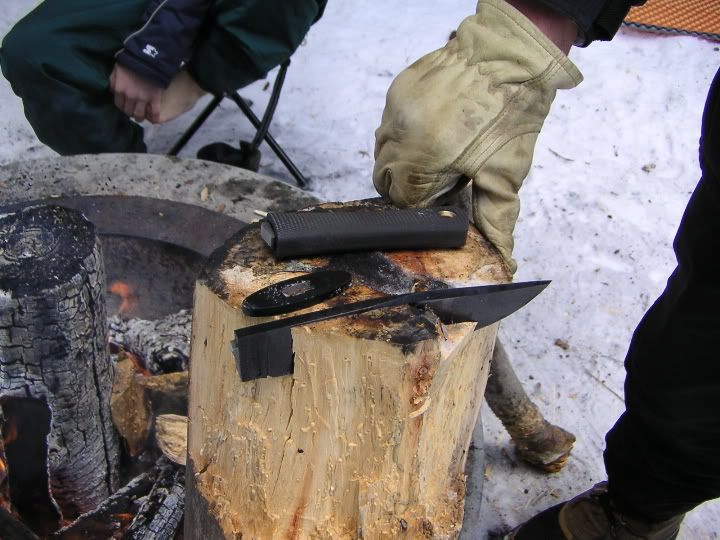First off I'm a Cold Steel fan... at least I have been. Good knives, designs, and fair prices and I've probably sold a few with my advocacy. I've been teaching winter survival skills to a young mens group in our church where I'm a youth leader. Currently we're doing firemaking skills with flint and steel; the real kind like when it's snowy outside, windy, and about 10 degrees out. I find few people can make a fire in such conditions and it takes some teaching and practice to build the skill and get confidence in doing it. And that's what we're doing.
Along with practice, as I've told the boys, you need a good survival knife. One that can hack wood and split logs under hard use. It's an essential piece of gear in the back country: not too heavy to be left behind but sturdy enough to do the job. That's where the CS Recon Scout comes in.
Most of the boys, at my recommendation, have purchased their own survival knife to be used in these exercises. My recommendations including Becker BK7s & 9s, CS Recon Scout, Kabar Next Gen, and SOG SEAL 2000; all good knives for their money. Or so I thought. A few bought the Recon Scout including another leader. It was this other leader's Recon Scout you see broken in half below.
The conditions on this winter campout were about 5 degrees and clear on this morning when we started to split some more wood. The other leader was just started to hammer the RS through the pictured log when I remarked what a good blade it was and how he was probably going to hand it down to his kids later on. Nice timing. No sooner had the words left my mouth when the blade literally shattered! We were in shock. The knife wasn't even taking a big split of that log either. The leader is currently getting it replaced under warranty as it was only a month old.

This is a very serious failure in my opinion. Splitting wood was mandatory to find the dry stuff in the snow. This was a no-kidding backpacking winter trip where a fire wasn't just nice to have it was almost mandatory. From preventing frost bite to drying clothes to cooking the fire was a necessity. If we'd been in another couple miles up the mountain and had no other backup blades (we had several) the loss of this Recon Scout could have been very serious indeed.
I don't know what CS makes the Carbon 5 steel out of but my confidence in their blades has taken a serious hit. Maybe they should put a warning on their C5 blades not to use them below 15 degrees. Failure of this sort is inexcusable no matter the cold or what not. A survival knife should take any condition you find yourself in... if it can't you should pitch it.
Along with practice, as I've told the boys, you need a good survival knife. One that can hack wood and split logs under hard use. It's an essential piece of gear in the back country: not too heavy to be left behind but sturdy enough to do the job. That's where the CS Recon Scout comes in.
Most of the boys, at my recommendation, have purchased their own survival knife to be used in these exercises. My recommendations including Becker BK7s & 9s, CS Recon Scout, Kabar Next Gen, and SOG SEAL 2000; all good knives for their money. Or so I thought. A few bought the Recon Scout including another leader. It was this other leader's Recon Scout you see broken in half below.
The conditions on this winter campout were about 5 degrees and clear on this morning when we started to split some more wood. The other leader was just started to hammer the RS through the pictured log when I remarked what a good blade it was and how he was probably going to hand it down to his kids later on. Nice timing. No sooner had the words left my mouth when the blade literally shattered! We were in shock. The knife wasn't even taking a big split of that log either. The leader is currently getting it replaced under warranty as it was only a month old.

This is a very serious failure in my opinion. Splitting wood was mandatory to find the dry stuff in the snow. This was a no-kidding backpacking winter trip where a fire wasn't just nice to have it was almost mandatory. From preventing frost bite to drying clothes to cooking the fire was a necessity. If we'd been in another couple miles up the mountain and had no other backup blades (we had several) the loss of this Recon Scout could have been very serious indeed.
I don't know what CS makes the Carbon 5 steel out of but my confidence in their blades has taken a serious hit. Maybe they should put a warning on their C5 blades not to use them below 15 degrees. Failure of this sort is inexcusable no matter the cold or what not. A survival knife should take any condition you find yourself in... if it can't you should pitch it.


